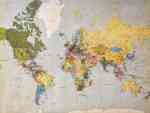Step 1 of 3•11 minutes read
Documents, Certification and Compliance
Documents and Certificates
To comply with the terms of the convention, every applicable vessel requires three main documents to be available on board.
International Ballast Water Management Certificate (IBWMC).
Ballast Water Management Plan (BWMP).
Ballast Water Record Book (BWRB).
If the vessel is fitted with a Ballast Water Management System (BWMS), a type approval certificate shall also be available onboard.
Some ports may require the sending of a Ballast Water Reporting Form (BWRF) as per the terms of the convention. Make sure to check with the arriving port if that state requires the vessel's Ballast Water Reporting Form (BWRF) before arrival, or if no additional information is required.
The Ballast Water Management Plan
Ballast Water Management Plan (BWMP) lays the foundation for any ballast water operations. In the plan, the Master, Officers, and Crew can find guidance and information regarding their company and regulation-approved procedures.
The Ballast Water Management Plan shall be specific to each vessel and written in the working language of the crew. If this language is not French, Spanish, or English, a copy must also be made in one of these languages for the use of surveyors and inspections. Details of the ship's safety procedures, and the crew associated with BWM as required by this Convention shall be included in the BWM Plan. The plan shall also cover, as a minimum:
-
A detailed description of the procedures for the disposal of sediments at sea and to shore.
-
How to coordinate shipboard BWM with the authorities of the State into whose waters discharge will take place.
-
A statement of who the designated officer on board is, and their duties.
-
How to fulfill the reporting requirements of the Convention.
The Ballast Water Record Book
The Ballast Water Record Book can be an electronic record system integrated with another record book or system. It could also be divided into two record books: A record of ballast operation and a Record for unusual events. All record books should be available for the port state. If there are any deviations from the BWMP and its procedures, the Port State shall be informed.
As a minimum, the record book should at least contain what is stated in Appendix II. This includes, but is not limited to:
-
Date and time.
-
Location Port or Facility of taking in Ballast Water, if at sea document Latitude and Longitude.
-
Estimated Volume of Uptake, in cubic meters.
-
Location of the Exchange Operation, if at sea document Latitude and Longitude.
-
Depth of Water at Exchange Location, in meters.
-
Estimated Volume of Ballast Water Discharged at Sea, in cubic meters.
-
Estimated Volume of Ballast Remaining, in cubic meters.
-
Estimated Volume of Ballast Water.
-
Discharge in Port or Facility, in cubic meters.
Once documented, this should also be signed off by the Officer in Charge and his or her rank. However, some ports may demand more information than stated above, and most of the time, the template is given by the company to suit the BWMP.

The three most influential authorities involved in the handling of Ballast Water are the; coastal state, flag state, and port state.
The Ballast Water Management Officer
The Ballast Water Management Plan should clearly state who is in charge of BWM. The BWM Officer's role is to ensure that the BWM Plan is followed and that the Ballast Water Record Book, BWRB, and other relevant documents are filled out correctly, to assist inspectors or other authorised persons if needed.
The responsibilities of the Ballast Water Management Officer are to control and supervise the Ballast Water handling, including sampling and testing, and to train the crew effectively to enable the correct processing of Ballast Water.
Authorities Ashore
Several authorities are involved in handling Ballast Water, and the three most influential are presented below.


